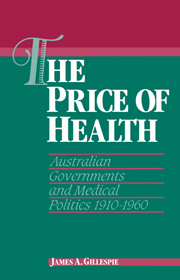Book contents
- Frontmatter
- Contents
- List of Tables
- Preface
- Acknowledgements
- Abbreviations
- Part I Medicine and the State: 1900 to 1939
- Chapter 1 ‘A Game of Animal Grab’: Medical Practice, 1920–1939
- Chapter 2 National Hygiene and Nationalization: the Failure of a Federal Health Policy, 1918–1939
- Chapter 3 Doctors, the States and Interwar Medical Politics
- Chapter 4 The Defeat of National Health Insurance
- Part II The Reconstruction of Medicine? Planning and Politics, 1940 to 1949
- Part III The Public and the Private
- Notes
- Bibliography
- Index
Chapter 2 - National Hygiene and Nationalization: the Failure of a Federal Health Policy, 1918–1939
Published online by Cambridge University Press: 22 September 2009
- Frontmatter
- Contents
- List of Tables
- Preface
- Acknowledgements
- Abbreviations
- Part I Medicine and the State: 1900 to 1939
- Chapter 1 ‘A Game of Animal Grab’: Medical Practice, 1920–1939
- Chapter 2 National Hygiene and Nationalization: the Failure of a Federal Health Policy, 1918–1939
- Chapter 3 Doctors, the States and Interwar Medical Politics
- Chapter 4 The Defeat of National Health Insurance
- Part II The Reconstruction of Medicine? Planning and Politics, 1940 to 1949
- Part III The Public and the Private
- Notes
- Bibliography
- Index
Summary
I well remember that, after the last war, my medical colleagues returned to Australia filled with a desire to apply to the civil community the great lessons of successful medical control and prevention of disease which had been applied in the army. I remember, too, the progressive sense of depression and disillusion with which they came to realize that there was no place for such measures in the civil social system.
Dr J.H.L.Cumpston, Commonwealth Director-General of Health, 1921–45.The interwar years saw the emergence of health care as a national political issue in Australia. While debate within the medical profession remained dominated by the immediate economic questions of markets, incomes and demarcation disputes between specialists and general practitioners, the upheavals of the First World War placed new intellectual and administrative problems at the centre of debate. Medical and population policy as the means to national renewal dominated thinking amongst public health doctors and a wide section of the medical profession. Stimulated by wartime experiments in medical control, this new public health lobby urged that the power of the state be harnessed to the wider project of health education and preventive medicine.
'National hygiene' was to be attained by the medical regulation of all stages of family life, from pregnancy through child rearing and nutrition, in order to build a superior Australian race.
- Type
- Chapter
- Information
- The Price of HealthAustralian Governments and Medical Politics 1910–1960, pp. 31 - 56Publisher: Cambridge University PressPrint publication year: 1991
- 1
- Cited by



